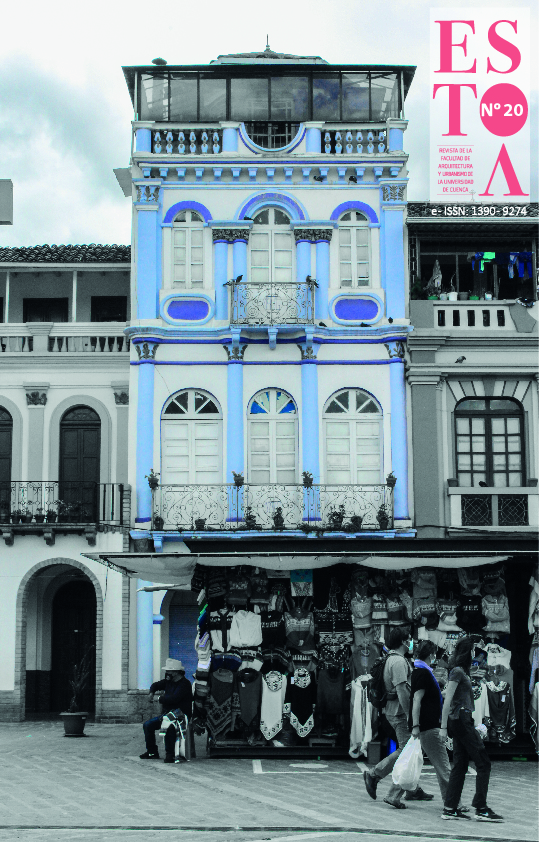The application of colour to modern architecture: A review of projects by Bruno Taut and Le Corbusier
DOI:
https://doi.org/10.18537/est.v010.n020.a13Keywords:
modern architecture, painting, colour, Le Corbusier, Bruno TautAbstract
Architecture and painting are at a turning point in the early part of the 20th century. The arrival of Modernity or International Style meant a rethinking of the ways of building, since materials such as concrete, iron or glass appeared on the scene, conditioning not only the constructive process, but also the aesthetics of the building. But this is not the only characteristic of this change. Colour, traditionally associated with the pictorial field, became part of architecture as a covering, which is applied in accordance with the purpose pursued by the designer, who in this case is also the architect. To put this aesthetic change into context, two projects will be analyzed, one by Bruno Taut and other by Le Corbusier.
Downloads
References
Arrarte, M. (2008). On the Bonding of Colour y Architecture: Colouring Modes. International Colour Association.
Batchelor, D. (2000). Cromophobia. Reaktion Books Ltd.
Boesiger, W. (1982). Le Corbusier (5ª ed.). Gustavo Gili.
Círculo de Bellas Artes (s.f.). Bruno Taut. https://www. circulobellasartes.com/biografia/bruno-taut/
Cohen, J. L. (2004). Le Corbusier. Taschen.
Curtis, W. J. R. (1987). Le Corbusier. Ideas y formas. Hermann Blume.
Diecisiete puntos de la arquitectura neoplasticista (2012, 19 de enero). Tecnne. https://tecnne.com/de-stijl/17puntos-de-la-arquitectura-neoplasticista/
García, J.M. (2002). Arquitectos alemanes, arquitextos desconocidos. Bruno Taut (1880-1938). Cuadernos del Instituto Juan de Herrera de la Escuela de Arquitectura de Madrid
Hernández, R., Fernández, C. y Baptista, P. (2010). Fundamentos de metodología de la investigación. McGraw-Hill
Mehaffy, M. y Salingaros, N. (2020, 23 de febrero). La arquitectura moderna imperialista ataca de nuevo (J. T. Franco, Trad.). Plataforma arquitectura. https://www. plataformaarquitectura.cl/cl/933905/la-arquitecturamodernaimperialista-ataca-de-nuevo
Mondrian, P. (1983). La nueva imagen en la pintura. La realización del neoplasticismo en la arquitectura del futuro lejano y de hoy. Colegio Oficial de Aparejadores y Arquitectos Técnicos de Murcia
Mújica, V. (2014, 1 de febrero). Vanguardias III. Historia de la arquitectura moderna. http://historiadearquitecturamoderna.blogspot.com/2014/02/ vanguardiasiii.html
Munárriz, J. (2013). Investigación y tesis doctoral en Bellas Artes. E-Prints Complutense.https://eprints.ucm. es/23022/1/Investigaci%C3%B3nTesisBBAA_Jaime_ Mun%C3%A1rriz.pdf
Pizza A. (1994). Después del cubismo. El Croquis, (4), 8-47
Premier, A. y Gasparini, K. (2017). Sustainable colour design in architecture: materials, technologies and products. Journal of the International Colour Association, 19, 34-46.
Ragot, G. (2019). Le Corbusier’s paradoxical appropiation in Pessac, France. En M. Corbin, I. Gournay y R. Freestone (Eds.), Iconic planned communities and thechallenge of change (pp. 238-322). University of Pennsylvania Press.
Rivera, D. (2015). Los poderes del leopardo. Colores, moral y arquitectura de John Ruskin a Frank Gehry. En D. Rivera, Color, textura y arquitectura contemporánea, (pp.11-22). Baumit. http://oa.upm.es/49395/1/Rivera_ Poderes_leopardo.pdf
Rüegg, A. y Le Corbusier (1997). Le Corbusier’s Color Keyboardsfrom 1931 and 1959. Birkhäuser
Sainz, J. (1997). Arquitectura y urbanismo del siglo XX. En J. Brihuega, J. Hernando Carrasco, J.A. Ramírez, T. Raquejo Grado, C. Reyero, J. Sainz, F. J. San Martín, y G. Solana (Eds.), Historia del arte 4. El mundo contemporáneo (pp. 265-335). Alianza Editorial. https://doi.org/10.13140/ RG.2.1.1235.2248.
Serra, J. (2013). Three color strategies in architectural composition. Color Research and Application, 38 (4), 238250. http://dx.doi.org/10.1002/col.21717
Serra, J. (2010). La versatilidad del color en la composición de la arquitectura contemporánea europea: contexto artístico, estrategias plásticas e intenciones [Tesis Doctoral, Universidad Politécnica de Valencia]. TESEO. https:// www.educacion.gob.es/teseo/imprimirFicheroTesis. do?idFichero=%2FappnNbNLRQ%3D
Torrico, E. (2020, 29 de junio). ¿Casas y escuelas anticovid? Cómo la arquitectura pospandemia ha moldeado siempre nuestras ciudades. El Confidencial. https://www.elconfidencial.com/multimedia/video/ cultura/2020-06-29/tuberculosis-y-covid-escuelas-airelibre-casas-terrazaspandemia_2658575/
Tournikiotis, P. (2001). La historiografía de la arquitectura moderna. En J. Sainz (Ed. y Trad.). Manuales universitarios de arquitectura 5. Celeste Ediciones SA.
Van Doesburg, T. (1985). La evolución de la Arquitectura Moderna en Holanda. En T. Van Doesburg (Ed.) Principios del nuevo arte plástico y otros escritos, (pp. 111-119). Colegio Oficial de Aparejadores y Arquitectos Técnicos de Murcia.
Villalobos, D. (2002). El color de Luis Barragán. Morés.
Published
How to Cite
Issue
Section
License
Copyright (c) 2021 Estoa. Revista de la Facultad de Arquitectura y Urbanismo

This work is licensed under a Creative Commons Attribution-NonCommercial-ShareAlike 4.0 International License.
The Journal declines any responsibility for possible conflicts derived from the authorship of the works that are published in it.
The University of Cuenca in Ecuador conserves the patrimonial rights (copyright) of the published works and will favor the reuse of the same ones, these can be: copy, use, diffuse, transmit and expose publicly.
Unless otherwise indicated, all contents of the electronic edition are distributed under a Creative Commons Attribution-NonCommercial-ShareAlike 4.0 International License.




